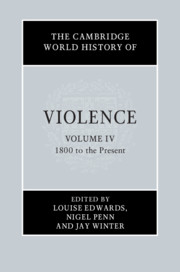Book contents
- The Cambridge World History of Violence
- The Cambridge History of Violence
- The Cambridge World History of Violence
- Copyright page
- Contents
- Figures and Maps
- Contributors to Volume IV
- Introduction to Volume IV
- Part I Race, Religion and Nationalism
- Part II Intimate and Gendered Violence
- Part III Warfare, Colonialism and Empire in the Modern World
- Part IV The State, Revolution and Social Change
- Part V Representations and Constructions of Violence
- 27 Criminal Violence and Culture in Europe
- 28 Extreme Violence in Western Cinema
- 29 Representing Violence through Media
- 30 ‘Never Forget that This Has Happened’: Remembering and Forgetting Violence
- Index
- References
28 - Extreme Violence in Western Cinema
from Part V - Representations and Constructions of Violence
Published online by Cambridge University Press: 13 March 2020
- The Cambridge World History of Violence
- The Cambridge History of Violence
- The Cambridge World History of Violence
- Copyright page
- Contents
- Figures and Maps
- Contributors to Volume IV
- Introduction to Volume IV
- Part I Race, Religion and Nationalism
- Part II Intimate and Gendered Violence
- Part III Warfare, Colonialism and Empire in the Modern World
- Part IV The State, Revolution and Social Change
- Part V Representations and Constructions of Violence
- 27 Criminal Violence and Culture in Europe
- 28 Extreme Violence in Western Cinema
- 29 Representing Violence through Media
- 30 ‘Never Forget that This Has Happened’: Remembering and Forgetting Violence
- Index
- References
Summary
This chapter examines the historical development and cultural significance of what has become known as “extreme violence” in western cinema: the visual depiction of violent action and its physical effects in a way that is particularly explicit when compared with cinematic norms and therefore more impactful. While there are myriad ways in which screen violence could be considered extreme, the three primary elements that usually come into play are: (1) visual—the explicit detail of physical bodily damage, often achieved through close-ups and detailed make-up special effects; (2) temporal—an uncomfortable duration in which the violence is held on screen for a period of time longer than would typically be considered narratively important; and (3) emotional—intense depiction of suffering and pain, often through close-ups of the human face in agony and the sounds of screaming. Throughout the history of western cinema various films have achieved levels of violence considered to be “extreme,” although not all of those films are still defined as such, having been surpassed by even more extreme levels of violence in contemporary filmmaking. How those definitions have changed tells us much about the interrelationships of social and political sensibilities, changing ethics, and the ever-evolving aesthetics of western filmmaking.
Keywords
- Type
- Chapter
- Information
- The Cambridge World History of Violence , pp. 580 - 597Publisher: Cambridge University PressPrint publication year: 2020



